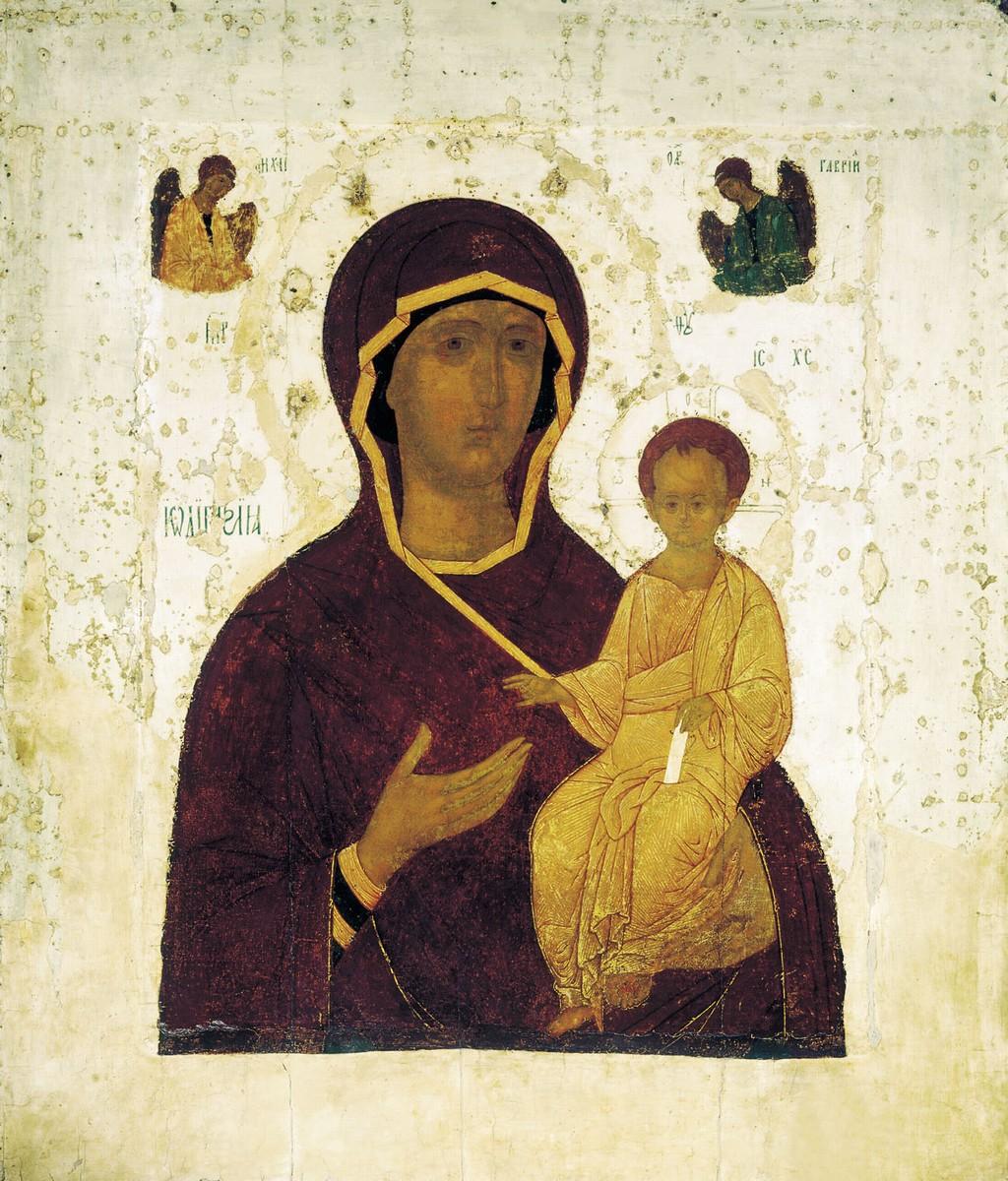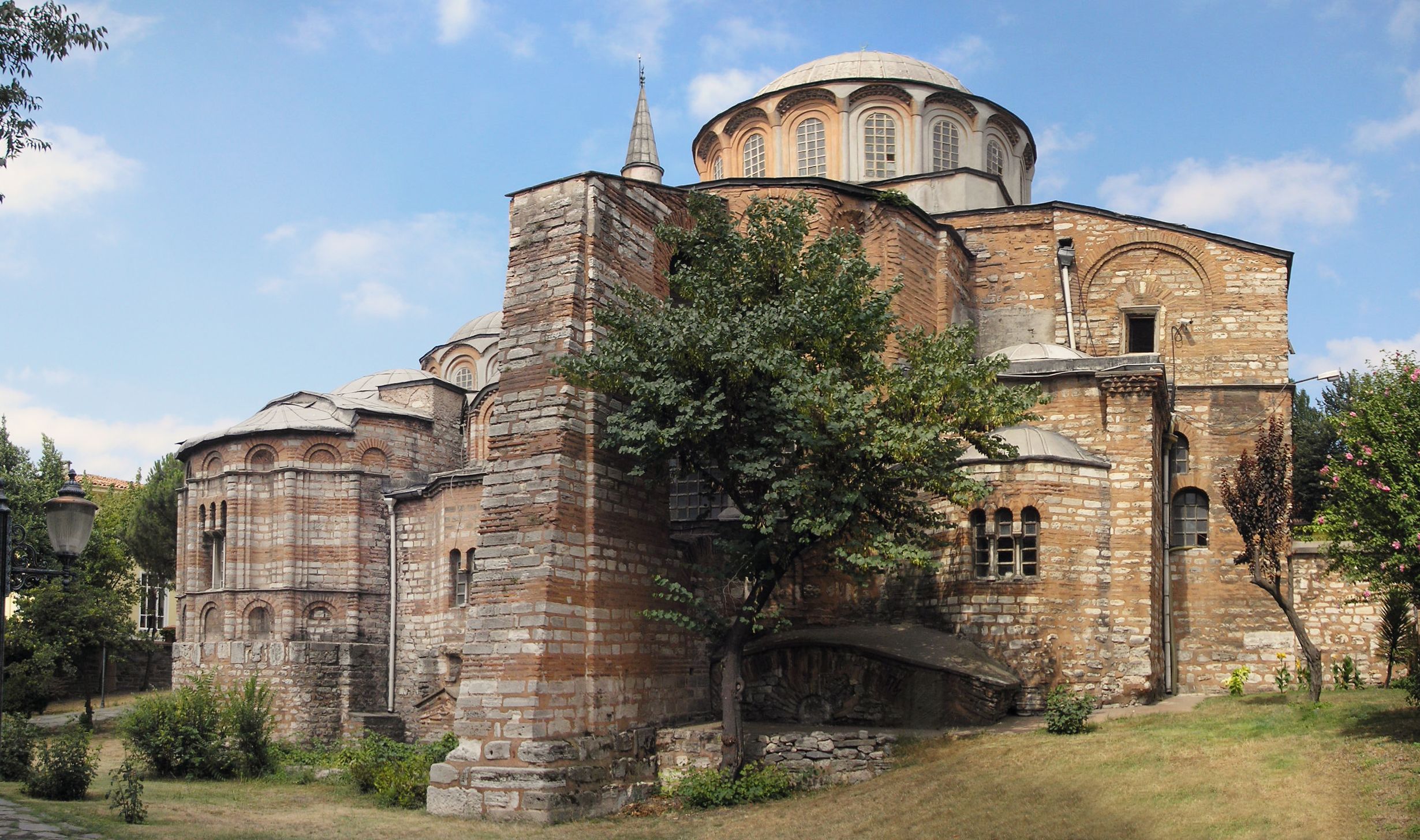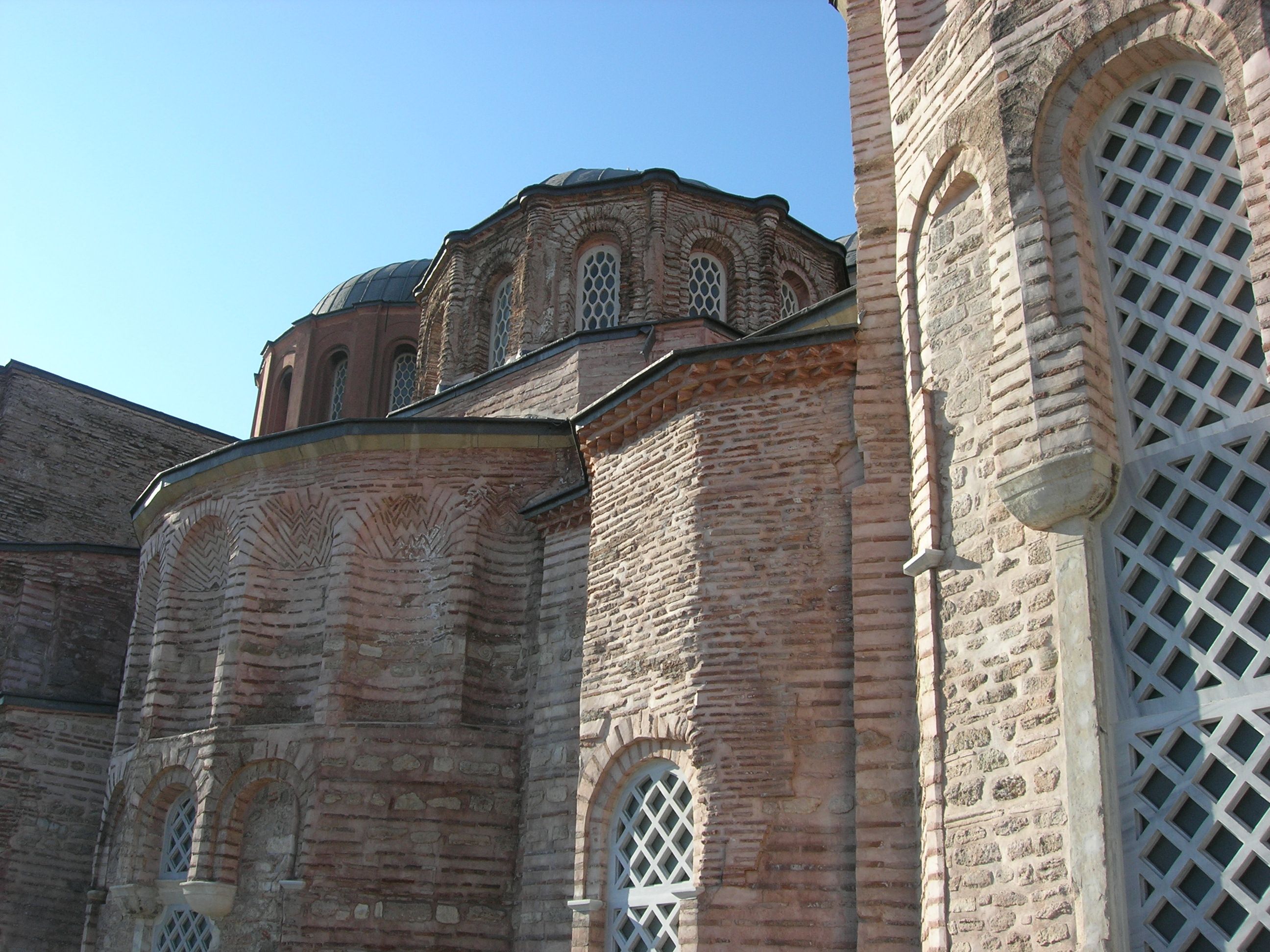|
Hodegetria
A Hodegetria, or Virgin Hodegetria, is an iconography, iconographic depiction of the Theotokos (Virgin Mary) holding the Child Jesus at her side while pointing to him as the source of salvation for humankind. The Virgin's head usually inclines towards the child, who raises his hand in a blessing gesture. Metals are often used to draw attention to young Christ, reflecting light and shining in a way to embody divinity. In the Western Church this type of icon is sometimes called Our Lady of the Way. The most venerated icon of the Hodegetria type, regarded as the original, was displayed in the Hodegon Monastery, Monastery of the Panaghia Hodegetria in Constantinople, which was built specially to contain it. Unlike most later copies it showed the Theotokos standing full-length. It was said to have been brought back from the Holy Land by Aelia Eudocia, Eudocia, the wife of emperor Theodosius II (408–450), and to have been painted by Saint Luke the evangelist, the attributed author of ... [...More Info...] [...Related Items...] OR: [Wikipedia] [Google] [Baidu] |
Hodegon Monastery
The Hodegon Monastery (also Monastery of the Panaghia Hodegetria or Monastery of the Hodegoi) in Constantinople was allegedly founded by Saint Pulcheria (399–453), a daughter of Emperor Arcadius. The monastery is considered one of the three main Marian foundations built in the city along with the Blachernai and the Chalkoprateia. The monastery was situated beyond the Chalkoprateia by the sea and served as the counterpart of the Blachernai so that these structures bracket the city of Constantinople as well as the processions such as the weekly Blachernai procession that began at the Theodosian walls and ended at Chalkoprateia. However, the exact location of the monastery is still subject to discussion. The Hodegon Monastery is believed to be named after the term ''hodegoi'', which referred to the guides who led the blind toward the miraculous well within the structure. Tradition states that the monastery held the Icon of the Hodegetria, believed to have been painted by Sain ... [...More Info...] [...Related Items...] OR: [Wikipedia] [Google] [Baidu] |
Chora Church
The Chora Church or Kariye Mosque () is a Byzantine architecture, Byzantine church, now converted to a mosque (for the second time), in the Edirnekapı, Istanbul, Edirnekapı neighborhood of Fatih district, Istanbul, Turkey. It is famous for its outstanding Late Byzantine mosaics and frescos. In the 16th century, during the Ottoman Empire, Ottoman era, it was converted into a mosque; it became a museum in 1945, and was turned back into a mosque in 2020 by President Recep Tayyip Erdoğan. The interior is covered with some of the finest surviving Byzantine Christian mosaics and frescoes, which were left in plain sight during Muslim worship throughout much of the Ottoman era. They were restored after the building was secularized and turned into a museum. The church in the western Fatih district of İstanbul. It stands on sedimentary layers and anthropogenic infills on a slope descending towards the north. It is oriented east-west, as are typical Byzantine churches throughout the ... [...More Info...] [...Related Items...] OR: [Wikipedia] [Google] [Baidu] |
Icon
An icon () is a religious work of art, most commonly a painting, in the cultures of the Eastern Orthodox, Oriental Orthodox, Catholic Church, Catholic, and Lutheranism, Lutheran churches. The most common subjects include Jesus, Mary, mother of Jesus, Mary, saints, and angels. Although especially associated with portrait-style images concentrating on one or two main figures, the term also covers most of the religious images in a variety of artistic media produced by Eastern Christianity, including narrative scenes, usually from the Bible or the lives of saints. Icons are most commonly painted on wood panels with egg tempera, but they may also be cast in metal or carved in stone or embroidered on cloth or done in mosaic or fresco work or printed on paper or metal, etc. Comparable images from Western Christianity may be classified as "icons", although "iconic" may also be used to describe the static style of a devotional image. In the Greek language, the term for icon painting uses ... [...More Info...] [...Related Items...] OR: [Wikipedia] [Google] [Baidu] |
Iconography
Iconography, as a branch of art history, studies the identification, description and interpretation of the content of images: the subjects depicted, the particular compositions and details used to do so, and other elements that are distinct from artistic style. The word ''iconography'' comes from the Ancient Greek, Greek ("image") and ("to write" or ''to draw''). A secondary meaning (based on a non-standard translation of the Greek and Russian equivalent terms) is the production or study of the religious images, called "Icon, icons", in the Byzantine art, Byzantine and Eastern Orthodox Churches, Orthodox Christian tradition. This usage is mostly found in works translated from languages such as Greek or Russian, with the correct term being "icon painting". In art history, "an iconography" may also mean a particular depiction of a subject in terms of the content of the image, such as the number of figures used, their placing and gestures. The term is also used in many academic ... [...More Info...] [...Related Items...] OR: [Wikipedia] [Google] [Baidu] |
Theotokos
''Theotokos'' ( Greek: ) is a title of Mary, mother of Jesus, used especially in Eastern Christianity. The usual Latin translations are or (approximately "parent (fem.) of God"). Familiar English translations are "Mother of God" or "God-bearer" – but these both have different literal equivalents in , and Θεοφόρος respectively. The title has been in use since the 3rd century, in the Syriac tradition (as ) in the Liturgy of Mari and Addai (3rd century)''Addai and Mari, Liturgy of''. Cross, F. L., ed. ''The Oxford Dictionary of the Christian Church''. Oxford University Press. 2005. and the Liturgy of St James (4th century). The Council of Ephesus in AD 431 decreed that Mary is the ''Theotokos'' because her son Jesus is both God and man: one divine person from two natures (divine and human) intimately and hypostatically united. The title of Mother of God (Greek: ) or Mother of Incarnate God, abbreviated ΜΡ ΘΥ (the first and last letter of main two words in ... [...More Info...] [...Related Items...] OR: [Wikipedia] [Google] [Baidu] |
Fall Of Constantinople
The Fall of Constantinople, also known as the Conquest of Constantinople, was the capture of Constantinople, the capital of the Byzantine Empire by the Ottoman Empire. The city was captured on 29 May 1453 as part of the culmination of a 55-day siege which had begun on 6 April. The attacking Army of the classical Ottoman Empire, Ottoman Army, which significantly outnumbered Constantinople's defenders, was commanded by the 21-year-old List of sultans of the Ottoman Empire, Sultan Mehmed the Conqueror, Mehmed II (later nicknamed "the Conqueror"), while the Byzantine army (Palaiologan era), Byzantine army was led by List of Byzantine emperors, Emperor Constantine XI Palaiologos. After conquering the city, Mehmed II made Constantinople the new Ottoman capital, replacing Edirne, Adrianople. The fall of Constantinople and of the Byzantine Empire was a watershed of the Late Middle Ages, marking the effective end of the Roman Empire, a state which began in roughly 27 BC and had la ... [...More Info...] [...Related Items...] OR: [Wikipedia] [Google] [Baidu] |
Zeyrek Mosque
Zeyrek Mosque () or the Monastery of the Pantokrator (; ), is a large mosque on the Fazilet Street in the Zeyrek district of Fatih in Istanbul, overlooking the Golden Horn. It is made up of two former Byzantine churches and a chapel joined together and represents the best example of Middle Byzantine architecture in Constantinople. After Hagia Sophia, it is the largest Byzantine religious edifice still standing in Istanbul. It is less than 1 km to the southeast of Eski Imaret Mosque, another Byzantine church that was turned into a mosque. East of the complex is an Ottoman Konak which has been restored and opened as a restaurant and tea garden called Zeyrekhane. History Byzantine period Between 1118 and 1124 the Byzantine Empress Irene of Hungary built a monastery on this site dedicated to Christ Pantokrator (Christ the Omnipotent).Krautheimer (1986), p. 409 The monastery consisted of a church (which became the katholikon, or main church, of the monasteryOusterhout (2 ... [...More Info...] [...Related Items...] OR: [Wikipedia] [Google] [Baidu] |
Hamilton Psalter
The Hamilton Psalter (Breviario Greco, with illuminations, 4to MS on velum am. 119 is an illustrated manuscript that consists of Psalms 1-150 and twelve canonical Odes. It is most notable among Byzantine manuscripts due to being one of the few surviving bilingual manuscripts from the Byzantine era, written primarily in Greek and Latin. There’s no sole author of the manuscript but it’s in fact a compilation of multiple scribes' writing. Its name is derived from being a part of the Hamilton Collection, arranged to be purchased from Alexander Hamilton, 10th Duke of Hamilton in 1882 by Wilhelm von Bode and Karl Friedrich Lippmann for the Royal Library in Berlin. It is currently housed within the Staatliche Museen Preussischer Kulturbesitz, Kupferstichkabinett Berlin. Patronage and Dating The 10th Duke of Hamilton had acquired the manuscript at the beginning of the nineteenth century, when Northern Italy dispersed a larger number of books due to the secularization of churches ... [...More Info...] [...Related Items...] OR: [Wikipedia] [Google] [Baidu] |
Saint Luke
Luke the Evangelist was one of the Four Evangelists—the four traditionally ascribed authors of the canonical gospels. The Early Church Fathers ascribed to him authorship of both the Gospel of Luke and the Acts of the Apostles. Prominent figures in early Christianity such as Jerome and Eusebius later reaffirmed his authorship, although a lack of conclusive evidence as to the identity of the author of the works has led to Authorship of Luke–Acts, discussion in scholarly circles, both secular and religious. The New Testament mentions Luke briefly a few times, and the Epistle to the Colossians refers to him as a physician (from Greek for 'one who heals'); thus he is thought to have been both a physician and a disciple of Paul the Apostle, Paul. Since the early years of the faith, Christians have regarded him as a saint. He is believed to have been a martyr, reportedly having been hanged from an olive tree, though some believe otherwise. The Eastern Orthodox Church, the Catholi ... [...More Info...] [...Related Items...] OR: [Wikipedia] [Google] [Baidu] |
Berlinghiero Berlinghieri 005
Berlinghiero also known as Berlinghiero Berlinghieri or Berlinghiero of Lucca (floruit, fl. 1228 – between 1236 and 1242), was an Italian painter in the Italo-Byzantine style of the early thirteenth century. He was the father of the painters Barone Berlinghieri, Bonaventura Berlinghieri, and Graco Berlinghieri. His actual name is unknown, as he is known from the inscription "Berlingerius me pinxit" on the crucifix which is the basis of attributing other works to the name. The form "Berlinghiero Berlinghieri", once common in art history, is certainly not his name according to Edward B. Garrison and most recent sources, however, his commonly accepted name is still Berlinghiero. He is also mentioned in a parchment of March 22, 1228, among the names of the residents of Lucca who swore to keep the peace with Pisa after a five-year war. The original document has been lost since the mid-19th century and only a somewhat garbled 17th-century transcription exists today, giving rise to ... [...More Info...] [...Related Items...] OR: [Wikipedia] [Google] [Baidu] |
Lectern
A lectern is a standing reading desk with a slanted top, on which documents or books are placed as support for reading aloud, as in a scripture reading, lecture, or sermon. A lectern is usually attached to a stand or affixed to some other form of support. To facilitate eye contact and improve posture when facing an audience, lecterns may have adjustable height and slant. People reading from a lectern, called lectors, generally do so while standing. The word has its origins in the medieval Latin term ''lectrum'', related to ''legere'' which means 'to read'. In pre-modern usage, the word ''lectern'' was used to refer specifically to the "reading desk or stand ... from which the Scripture lessons (''lectiones'') ... are chanted or read." One 1905 dictionary states that "the term is properly applied only to the class mentioned [church book stands] as independent of the pulpit." By the 1920s, however, the term was being used in a broader sense; for example, in reference to a memorial se ... [...More Info...] [...Related Items...] OR: [Wikipedia] [Google] [Baidu] |









